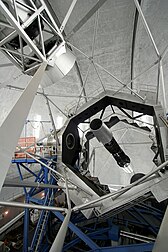
The W. M. Keck Observatory is an astronomical observatory with two telescopes at an elevation of 4,145 meters (13,600 ft) near the summit of Mauna Kea in the U.S. state of Hawaii. Both telescopes have 10 m (33 ft) aperture primary mirrors, and, when completed in 1993 and 1996, they were the largest optical reflecting telescopes in the world. They are currently the third and fourth largest.
Glass-ceramics are polycrystalline materials produced through controlled crystallization of base glass, producing a fine uniform dispersion of crystals throughout the bulk material. Crystallization is accomplished by subjecting suitable glasses to a carefully regulated heat treatment schedule, resulting in the nucleation and growth of crystal phases. In many cases, the crystallization process can proceed to near completion, but in a small proportion of processes, the residual glass phase often remains.

Pyrex is a brand introduced by Corning Inc. in 1915 for a line of clear, low-thermal-expansion borosilicate glass used for laboratory glassware and kitchenware. It was later expanded in the 1930s to include kitchenware products made of soda–lime glass and other materials.

Fused quartz,fused silica or quartz glass is a glass consisting of almost pure silica (silicon dioxide, SiO2) in amorphous (non-crystalline) form. This differs from all other commercial glasses in which other ingredients are added which change the glasses' optical and physical properties, such as lowering the melt temperature. Fused quartz, therefore, has high working and melting temperatures, making it less desirable for most common applications.

Invar, also known generically as FeNi36, is a nickel–iron alloy notable for its uniquely low coefficient of thermal expansion. The name Invar comes from the word invariable, referring to its relative lack of expansion or contraction with temperature changes, and is a registered trademark of ArcelorMittal.

Lampworking is a type of glasswork in which a torch or lamp is used to melt the glass. Once in a molten state, the glass is formed by blowing and shaping with tools and hand movements. It is also known as flameworking or torchworking, as the modern practice no longer uses oil-fueled lamps. Although lack of a precise definition for lampworking makes it difficult to determine when this technique was first developed, the earliest verifiable lampworked glass is probably a collection of beads thought to date to the fifth century BCE. Lampworking became widely practiced in Murano, Italy in the 14th century. As early as the 17th century, itinerant glassworkers demonstrated lampworking to the public. In the mid-19th century lampwork technique was extended to the production of paperweights, primarily in France, where it became a popular art form, still collected today. Lampworking differs from glassblowing in that glassblowing uses a furnace as the primary heat source, although torches are also used.
Thermal shock is a phenomenon characterized by a rapid change in temperature that results in a transient mechanical load on an object. The load is caused by the differential expansion of different parts of the object due to the temperature change. This differential expansion can be understood in terms of strain, rather than stress. When the strain exceeds the tensile strength of the material, it can cause cracks to form and eventually lead to structural failure.

Borosilicate glass is a type of glass with silica and boron trioxide as the main glass-forming constituents. Borosilicate glasses are known for having very low coefficients of thermal expansion, making them more resistant to thermal shock than any other common glass. Such glass is subjected to less thermal stress and can withstand temperature differentials without fracturing of about 165 °C (300 °F). It is commonly used for the construction of reagent bottles and flasks, as well as lighting, electronics, and cookware.
Vycor is the brand name of Corning's high-silica, high-temperature glass. It provides very high thermal shock resistance. Vycor is approximately 96% silica and 4% boron trioxide, but unlike pure fused silica, it can be readily manufactured in a variety of shapes.

Schott AG is a German multinational glass company specializing in the manufacture of glass and glass-ceramics. Headquartered in Mainz, Germany, it is owned by the Carl Zeiss Foundation. The company's founder and namesake, Otto Schott, is credited with the invention of borosilicate glass.

Athermalization, in the field of optics, is the process of achieving optothermal stability in optomechanical systems. This is done by minimizing variations in optical performance over a range of temperatures.
Ultra low expansion glass (ULE) is a registered trademark of Corning Incorporated. ULE has a very low coefficient of thermal expansion and contains as components silica and less than 10% titanium dioxide. Such high resistance to thermal expansion makes it very resistant to high temperature thermal shock. ULE has been made by Corning since the 1960s, but is still very important to current applications.

Glass-to-metal seals are a type of mechanical seal which joins glass and metal surfaces. They are very important elements in the construction of vacuum tubes, electric discharge tubes, incandescent light bulbs, glass-encapsulated semiconductor diodes, reed switches, glass windows in metal cases, and metal or ceramic packages of electronic components.
Ohara Inc. is a Japanese global glass manufacturing company. The company is headquartered in Sagamihara with subsidiaries in a number of countries, including Japan, the United States, Germany, Hong Kong, Malaysia, Taiwan, and China, with Ohara Corporation being the U.S. subsidiary of the Ohara Group. Ohara manufactures glasses since 1935, the year of its founding.
Sitall is a crystalline glass-ceramic with ultra-low coefficient of thermal expansion (CTE). It was originally manufactured in the former Soviet Union and was used in the making of primary mirrors for the Russian Maksutov telescopes, but since dissolution has diminished in quality. It has a CTE of only 0 ± 1.5×10−7 °C−1 in the temperature range −60 to 60 °C, placing it in a small group of transparent materials with low CTE such as Vycor, Zerodur, Cer‑Vit and fused quartz.
Macor is the trademark for a machinable glass-ceramic developed and sold by Corning Inc. It is a white material that looks somewhat like porcelain. Macor is a good thermal insulator and is stable up to temperatures of 1000 °C, with very little thermal expansion or outgassing. It can be machined using standard metalworking tools.
Optothermal stability describes the rate at which an optical element distorts due to a changing thermal environment. A changing thermal environment can cause an optic to bend due to either 1) changing thermal gradients on the optic and a non-zero coefficient of thermal expansion, or 2) coefficient of thermal expansion gradients in an optic and an average temperature change. Therefore, optothermal stability is an issue for optics that are present in a changing thermal environment. For example, a space telescope will experience variable heat loads from changes in spacecraft attitude, solar flux, planetary albedo, and planetary infrared emissions. Optothermal stability can be important when measuring the surface figure of optics, because thermal changes are typically low frequency which makes it difficult to use measurement averaging to remove errors. Also, optothermal stability is important for optical systems which require a high level of stability such as those that use a coronagraph.

DURAN is a brand name for the internationally defined borosilicate glass 3.3 produced by the German company DURAN Group GmbH since 2005 under license from the Schott AG, which was the first to develop it, and which sold it from 1893 until the equity carve-out of the DURAN Group in 2005. Because of its high resistance to heat and temperature changes, as well as its high mechanical strength and low coefficient of thermal expansion, DURAN, which Pyrex from Corning is similar to, is not only used for laboratory devices but also in cathode ray tubes, transmitting tubes, and speculums.
Optical glass refers to a quality of glass suitable for the manufacture of optical systems such as optical lenses, prisms or mirrors. Unlike window glass or crystal, whose formula is adapted to the desired aesthetic effect, optical glass contains additives designed to modify certain optical or mechanical properties of the glass: refractive index, dispersion, transmittance, thermal expansion and other parameters. Lenses produced for optical applications use a wide variety of materials, from silica and conventional borosilicates to elements such as germanium and fluorite, some of which are essential for glass transparency in areas other than the visible spectrum.











